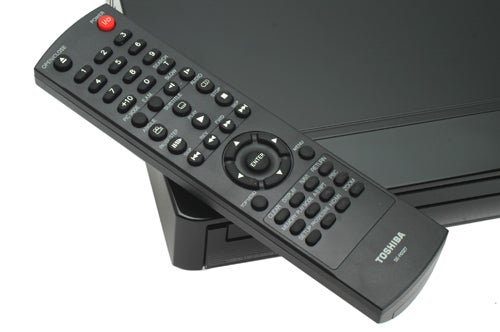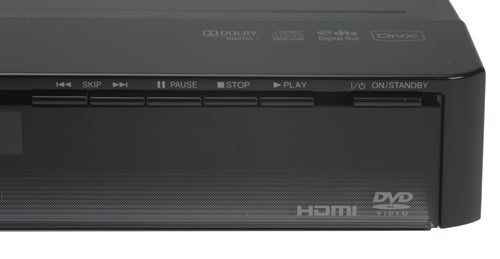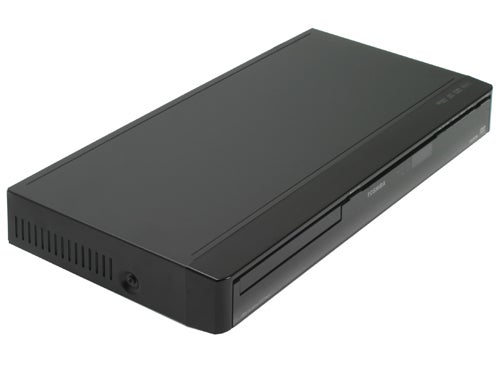Toshiba XD-E500 Upscaling DVD Player Review
Toshiba XD-E500 Upscaling DVD Player
With the demise of HD DVD, Toshiba has turned its attention back to DVD.

Verdict
Key Specifications
- Review Price: £129.99
2008 has been a pretty tough year for Toshiba. After Warner turned its back on HD DVD in January and essentially killed the format off, Toshiba had to go back to the drawing board as far as high definition went. For the past three years Toshiba has been pushing HD DVD as the single most important aspect of any home cinema setup, so now that it’s gone, what’s filling the gap? Strange as it may seem, Toshiba feels that the HD DVD breach can be filled with, err, DVD.
While at IFA recently, Toshiba put forward the idea that the majority of consumers are still watching SD content, so the lack of a true HD source device in its line up isn’t that much of an issue. Now, although it’s probably true that most consumers are still watching SD on their HDTVs, this new message from Toshiba is somewhat at odds with the message the company has been putting out for the past couple of years. Let’s face it, if Toshiba really believed that consumers aren’t interested in HD source devices, why was it pushing HD DVD?
Anyway, let’s put Toshiba’s u-turn to one side and concentrate on the product in front of me right now – the XD-E500. The XD-E500 is a DVD player, but it’s the most advanced DVD player that Toshiba has ever brought to market. Although Toshiba has been selling upscaling DVD players for many years, this is the first to incorporate the company’s eXtended Detail Enhancement, or XDE technology – clearly EDE didn’t sound as cutting edge, so Toshiba grabbed the second letter of the first word for the acronym.
The XD-E500 looks similar to Toshiba’s other upscaling DVD players, in that it’s slim, shallow and very light. Although the lack of substance isn’t an issue in a player that costs less that £50, like Toshiba’s own SD-480E, it’s somewhat disappointing in a deck that will set you back around £130 on the street. The front fascia is reasonably busy, with a full complement of control buttons, along with the power button on the right. The left is dominated by the disc tray, with an Open/Close button to the right of it. There’s a small display that indicates track information, and next to this is an array of indicator lights that show what mode of output has been selected.
The rear is fairly standard with the all important HDMI port, a set of component video connectors, SCART and composite video. You also get stereo analogue audio outputs, along with both optical and coaxial digital audio outs.
The remote is neither disappointing nor exciting – it’s pretty much exactly what you’d expect from a DVD player these days. However, considering that this player is well over twice the price of Toshiba’s SD-480E, I can’t help but feel that a slightly improved remote control would have been nice – just some backlighting for key buttons would be enough. 
The feature list of the XD-E500 certainly looks good. What you have is a DVD player that can upscale to 720p, 1080i and 1080p – it will even output 1080p 24Hz, but there are some issues with that, which I will come to later. There’s no integrated audio decoding hardware, so if you want to make use of Dolby Digital or DTS soundtracks, you’ll need to output the bitstream digitally and use an external receiver or amp.
You also get DivX support, so if you’ve encoded a library of video on your PC, you’ll be able to play it back on your TV using the XD-E500. However, it’s worth noting that there is no USB port or network connectivity on offer, so if you did want to playback DivX or Xvid content, you’d first have to burn it to a CD or DVD, which is somewhat cumbersome. 
Of course it’s the DVD upscaling that’s the real party piece of this player, and the question is whether it’s really any better than upscaling players costing a fraction of the price. The XDE technology used here was announced a couple of weeks ago at IFA, along with Toshiba’s Resolution+ technology, which works at the other end of the chain in TVs. According to Toshiba, XDE analyses the source image, and sharpens edges to reduce jaggies, which often plague upscaled content. It also applies colour and contrast processing to, allegedly, create a more vivid and lifelike scene. The result, according to Toshiba, is a “near HD” image, that allows consumers to enjoy their existing DVD library on their HD screen, without the need to invest in a new standard – read, Blu-ray!
First let me say that the upscaling produced by the XD-E500 is pretty damn good. Hooking the player up to my Pioneer Kuro PDP-LX5090 gave the XD-E500 the best possible platform on which to demonstrate its upscaling talents, and although the results are still a fair way behind a good, native high definition source, there’s a significant improvement over a standard definition DVD feed.
I slotted my Black Hawk Down Special Edition DVD into the XD-E500 and set the output to 1080p over HDMI. What I was greeted with was a very crisp and clean picture. There was surprisingly little evidence of jaggies, indicating that the XDE sharpness enhancements were doing their job. The level of detail in facial close ups was also impressive, as was the definition of debris and smoke during explosions and fire fights. XDE’s improved contrast processing also shone through in the film’s night time scenes, giving proceedings the nervous, claustrophobic feel that Ridley Scott was shooting for. 
However, direct comparisons to the Black Hawk Down Blu-ray hammered home the point that no matter how good a player is at upscaling, it can only work with the detail that’s present in the original source. The Blu-ray (played via a PlayStation 3), simply offered a more cinematic picture, with detail that simply wasn’t present when watching the DVD on the XD-E500. It’s also worth noting that Black Hawk Down isn’t even a particularly good Blu-ray print, encoded using MPEG 2 and a very modest bit rate.
Turning to something far more colourful like Spider-Man, and the XD-E500 tries to work its magic, but manages mixed results. The images definitely appear sharper than a non-upscaled source, but colours take on a slightly oversaturated look – I know that the film is supposed to have a comic book feel, but the XD-E500 takes things a little too far. And of course, compared to the natively high definition Blu-ray, the XD-E500’s image looks a generation behind – which of course, it is.
More worrying though, is that the XD-E500 just doesn’t offer enough over existing upscaling products, including it’s own players. Add to that the fact that a Blu-ray player, or even Toshiba’s old HD DVD players will also upscale DVDs very convincingly, and the argument for a £130 DVD device starts to look shaky. And when you consider that you can buy a standalone Blu-ray deck for as little as £160 online, I can’t see why anyone would want to buy hardware based on outgoing media.
Now, remember that 24fps feature I mentioned earlier? Well, although 1080p 24Hz is definitely the feature of the moment when it comes to HD sources, it brings with it a few problems when you’re working in the DVD arena. The issues come from the way NTSC and PAL DVDs are created. Because the PAL TV system works on a 50Hz interlaced standard, it means that video needs to be encoded at 25fps, with each frame split into two, thus creating PAL 50Hz. Since film is shot at 24fps, the easiest way to convert it to 25fps is to simply speed it up by a factor of four per cent – thus giving you one extra frame per second.
Converting film to an NTSC format on the other hand is far more complicated, since NTSC employs a 60Hz interlaced standard. This means that the original 24fps film has to be converted to 30fps and then interlaced. To achieve this a method called 3:2 pulldown is employed – this process is complicated, messy and often produces questionable results. It does at least avoid the slight change in audio pitch that occurs using the PAL speed up method, but unless you flick between a PAL encoded movie and an original source, you’re unlikely to notice that.
According to Toshiba, the XD-E500 is able to reverse the 3:2 pulldown process, thus recreating a 24fps stream, which is an interesting concept. So you’re starting with a 24fps source, that the goes through significant post processing to create the 60Hz interlaced output that the NTSC TV system requires, that 60Hz interlaced stream is then reconstituted into a 24Hz signal by the XD-E500 before being sent to your TV. That’s quite a lot of processing to get you back to where you started!
You may have noticed from the paragraph above, that the 24fps feature on the XD-E500 is only applicable to NTSC sources, where the reverse 3:2 pulldown processing can be applied. This brings a slight issue to UK consumers, since our discs are PAL and therefore the 24fps feature is pretty much useless. Add to this the fact that the XD-E500 is region coded, so you couldn’t play Region 1 NTSC discs even if you wanted to, and it’s clear that this feature is for the US market only. Of course you can hack the player to be multi-region, as I always do, but how many average consumers bother, and then also bother to import Region 1 discs in the first place?
Toshiba pointed out that the 24fps feature isn’t really needed for PAL sources, since the XD-E500 is already outputting a 25fps 1080 progressive signal, but the problem with that argument is that modern HDTVs are looking for a 1080p 24fps signal, not a 1080p 25fps one. As such, TVs will not apply the even pulldown techniques that are used to ensure smooth and fluid playback with a 24fps source. Toshiba’s own TVs offer a 5:5 pulldown feature for 1080p 24Hz signals, resulting in smooth 120Hz playback. Other manufacturers use 3:3 or 4:4 methods, but they all look for a 1080p 24Hz input before applying those methods. And let’s not forget that these TVs are expecting a signal from an HD source like Blu-ray, where the movie has been encoded at 24fps in the first place.
There’s no doubt that the XD-E500 is a decent DVD player, but the question is whether anyone should still be investing money in DVD at this point in the game. There’s a solid argument for buying a cheap upscaling DVD player for the secondary TV in your house, but the XD-E500 is, by no means, a cheap DVD player. And with the price of Blu-ray players dropping every day, I find it impossible to suggest that anyone buy a DVD player for £130, no matter how impressive its upscaling is. 
”’Verdict”’
I sincerely hope that Toshiba comes to its senses sometime soon and starts to produce Blu-ray players, because if the company keeps its head firmly in the sand, it’s going to seriously damage its standing in the home entertainment arena. Now that the format war is over, Blu-ray is likely to become the standard format for the next eight years or so, if DVD’s lifetime is anything to go by, and Toshiba needs to be part of that picture.
As for the XD-E500, it’s a good upscaling DVD player, but it’s just far too expensive compared to other DVD decks, and even entry level Blu-ray players. Clearly Toshiba has put a lot of research into the XDE picture processing, and it’s a shame that we never saw this technology implemented in an HD DVD player, which is no doubt where it was meant to be used all along.
Ultimately, no matter how good your upscaling and picture processing, you can’t create detail, you can only enhance what’s there in the first place. As such, the XD-E500 is never going to produce pictures as good as a Blu-ray player with true, high definition content. Considering its price, you’re simply better off buying an entry level Blu-ray deck and starting your high definition collection now.
Trusted Score
Score in detail
-
Performance 6
-
Features 6
-
Value 4
-
Design 6

